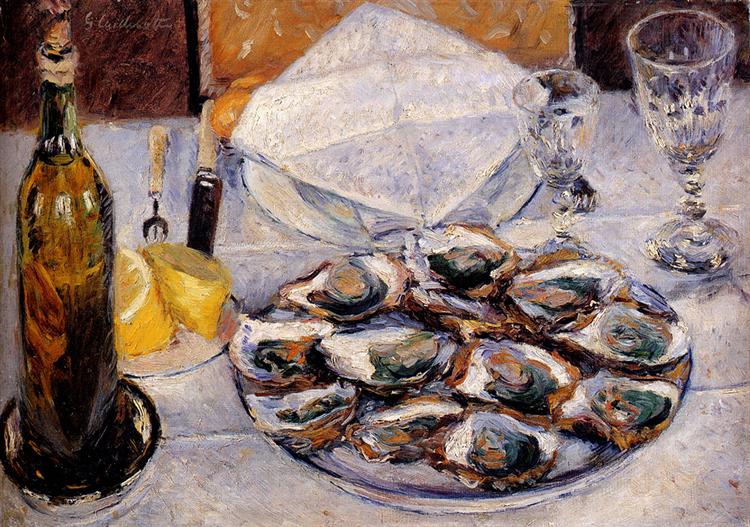Descriere
Gustave Caillebotte's painting "Still Life with Oysters", created in 1881, stands as an exceptional example of Impressionist art's innovative approach to depicting everyday life and exploring light and colour. Often overlooked in comparison to the great names of his contemporaries, Caillebotte arouses interest not only for his technical prowess, but also for his ability to capture the essence of everyday objects with intricate attention to detail.
When looking at this work, we are presented with a composition that focuses on an exquisite arrangement of oysters on a table covered with a white tablecloth. The use of the tablecloth, skillfully illuminated, introduces a tone of elegance and simplicity to the setting, reinforcing the central theme of still life itself. The oysters, carefully but informally arranged, stand out for their matte hue and diversity of textures. Caillebotte does not simply present these mollusks as mere food; he gives them life, displaying variations in colors ranging from gray to a subtle greenish tone, which infuses the work with a sense of freshness and organicity.
Natural light plays a crucial role in the interpretation of this painting. It filters through a window, creating a magnificent contrast between shadows and reflections, which trembles with the touch of impressionism. The luminosity illuminates the surfaces of the oysters and the tablecloth, enhancing their material interplay, while the shadows add depth and a palpable three-dimensionality. This use of light, so characteristic of Caillebotte, signals his fascination with the interaction of light with objects and the space around them.
Although the work lacks human figures, its impact lies in the atmosphere it evokes. The absence of characters does not diminish the visual narrative; on the contrary, it suggests a life passing by, perhaps in anticipation of a shared meal or in contemplation of the moment. This element of latent life becomes a small homage to everyday action in a domestic setting, which resonates with the warmth of the familiar.
Gustave Caillebotte is known for his unique approach and ability to elevate the ordinary into the extraordinary, and this work perfectly embodies that philosophy. He is often associated with his Impressionist contemporary Claude Monet, from whom Caillebotte learned the importance of light and color. However, his technique is distinguished by an attention to detail that is more reminiscent of the clarity of realism than the more ephemeral approach of Impressionism.
Still Life with Oysters also reflects Caillebotte's interest in bourgeois life and the new gastronomy of his time, in the context of late 19th-century Paris. In a period when the middle class was flourishing, oysters symbolised not only the everyday sphere, but also a certain degree of sophistication in gastronomy. The work can therefore be interpreted as a reflection of the culture and values of his time, a hail of good living and the pleasure of the senses.
In short, Still Life with Oysters is more than just a study of forms; it is a window into understanding Caillebotte's aesthetics and his uniqueness within the art scene of his time. The work invites contemplation not only of the object depicted, but also of the environment and atmosphere that surrounds it, in a beautiful balance between nature, light and everyday life.
KUADROS ©, a famous painting on your wall.
Hand-made oil painting reproductions, with the quality of professional artists and the distinctive seal of KUADROS ©.
Painting reproduction service with satisfaction guarantee. If you are not completely satisfied with the replica of your painting, we will refund 100% of your money.

